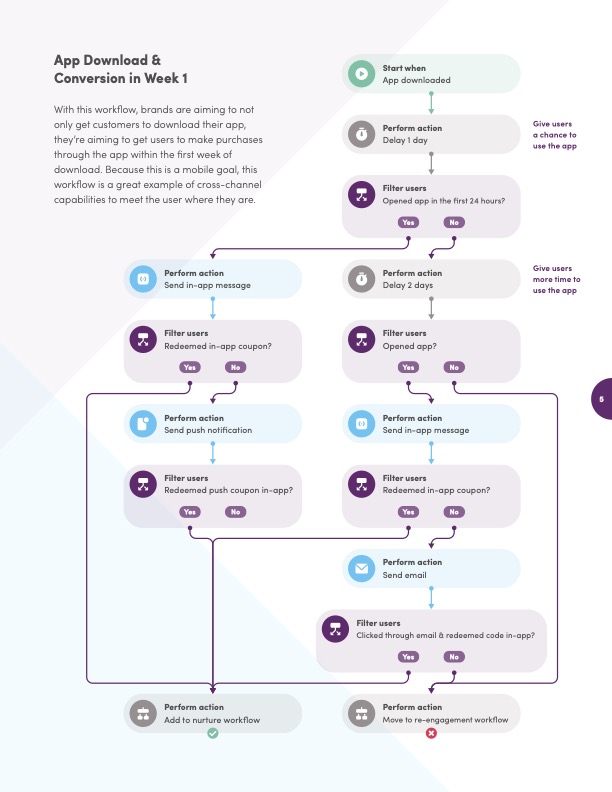What is a Marketing Workflow?
A marketing workflow refers to the sequenced marketing messaging you send to a customer to guide them through each stage of their customer journey.
Workflows help your customers navigate through every stage of their lifecycle, starting with their first brand interaction, through their research and consideration phase, and ultimately helping convert and retain them as loyal, high-value customers. Your workflows should support activation, nurturing, and re-engagement throughout the entire customer relationship.
It’s important to customize the workflow not just to the stage in the customer journey (top, middle, or bottom of the funnel), but to personalize both your content and channel delivery based on each customer’s unique needs, preferences, and behavioral history.
By developing effective workflows for each type of customer interaction, customers will be able to seamlessly navigate to the next stage in the customer journey while receiving a best-in-class customer experience.
Here’s a look at how to do that.
How to Set Up a Marketing Workflow
When developing your marketing workflows, implementing marketing automation is crucial. Be sure to use a sophisticated solution, like Iterable.
Your marketing solution should integrate data from all of your marketing tools (including your web and app analytics, e-commerce solution, email marketing solution, CRM, and other tools) so that you can generate a unified, 360-degree customer profile for each customer, no matter where they are in the marketing lifecycle. You should be able to build user profiles that integrate demographic data, zero-party data, and real-time behavioral data, to develop deep customer segmentation practices down to the individual level.
Then, start building unique workflows by defining what goal you want to achieve within each workflow. For example, some of your goals might include items like:
- Click on a promotional email CTA
- Fill out customer profile
- Download ebook
- View video
- Purchase subscription
- Upgrade subscription
- Renew subscription
- Purchase item
- Provide review
For each goal, you’ll need to set up a unique path that helps guide the customer towards achieving the objective. The marketing workflow should be both tailored to the individual goal, and tailored to the individual customer.
For example, page five of our Workflow Lookbook shows a workflow with the goal of getting a customer to convert within a week of downloading your app. The workflow begins as soon as customer has downloaded your app.


First, you’ll see if they open the app within 24 hours after they download it. If yes, you can plan to send them an in-app message with a coupon. If not, you could delay further messaging until they do. If they received the in-app message but didn’t redeem the coupon, you could nudge them to do so with a push notification, featuring the same coupon. If they’re still not engaging and haven’t opened the app, you can try sending an email, reminding them of the in-app offer. You can customize the workflow—in real-time—by sending reminders based on time or action, optimizing for engagement on the channel they’re most likely to interact with.
Personalizing Your Marketing Workflows
Once you’ve gathered more customer data, both directly from the customer (zero-party data) and from their web and app browsing behavior, you can use personalized recommendations to improve your marketing workflows as you build your nurture and re-engagement sequences.
For example, if a customer visits an itinerary page for your travel company’s adventure tour to New Zealand, but doesn’t book it, you can send a follow-up sequence to them sharing a video of the tour and inviting them to add the tour to their wishlist, or to put a hold on the tour, free of charge, if they’re not ready to book yet. If they don’t respond, that might trigger another follow up message sharing FAQs and encouraging them to request a call with a travel consultant to help them plan their trip. You’ll be able to deploy the messaging sequence across all the marketing channels that your customers use, focusing on those that they typically use to engage with your brand to maximize the likelihood that they’ll respond to the offer.
Personalization can use Catalog features to offer customized recommendations for additional products or services that your customers may be interested in, based on their purchasing or browsing history. For example, if a customer previously went on a tour of Portugal in Spring, you might start sending them offers in Fall recommending similar European trips, with an exclusive discount for past customers.
The Benefits of Developing Marketing Workflows
Your customers all have different priorities and different journeys, so it’s important to meet them where they are with content that’s personally relevant to them, on the channels they prefer to engage with.
By developing a variety of marketing workflows for different segments of customers, you’ll be able to build and scale the right approach to nurture each customer and help them achieve your marketing goal, whatever that might be. Whether you’re onboarding customers, educating them about your brand, incentivizing them to make a purchase or order a subscription, or encouraging them to re-engage with your brand, you can develop the right series of messages to engage with them.
Each workflow will be customized and can adapt automatically based on the customer’s response. If a customer reaches the goal, the sequence will end, but if the customer doesn’t engage on one channel, your messaging will shift to a new marketing channel to optimize the likelihood of interaction. With every workflow, you can include dynamic content that personalizes the messaging to each customer, including their name, location, brand or style preferences, purchase history, and other data points, ensuring that the content is always highly relevant.
By optimizing your marketing strategy with dedicated marketing workflows, you’ll be able to continually engage your customers at scale, resulting in higher revenue and higher customer retention.































